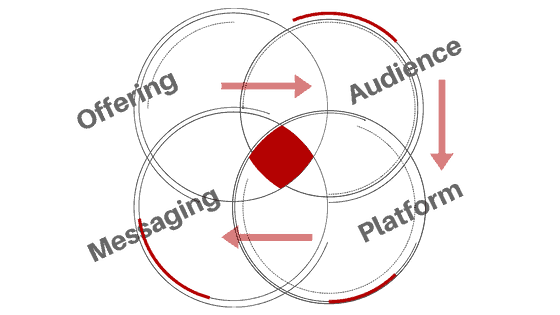5 Most Common Mistakes In Jewish Marketing
Learn about the 5 most common mistakes made in Jewish marketing and how you can avoid and remedy them to successfully meet your marketing goals.
When approached by prospective clients, often, many have already made some form of Jewish focused marketing effort. Usually, they get in touch because their efforts have had disappointing results. Upon initial review of past marketing activity, we see many of the same mistakes that act as roadblocks and prevent clients from reaching their target and optimal Jewish demographic. While there are commonly numerous distinct issues that are present in each client’s specific circumstance, there are a few marketing mistakes that command an overarching presence across the board. We, therefore, believe that it will be helpful to discuss the five most common errors in Jewish marketing and how to remedy them so that those interested in embarking on a Jewish focused marketing campaign can know what to be aware of and what to do to fix common errors.
You may want to read our related discussion on general “Jewish Marketing Tips” in conjunction with this discussion.
Mistake #1: Wrong Platform

Take, for example, a recent client, a vendor in the fashion and lifestyle space with considerable resources set aside to spend on a Jewish advertising campaign. Before our contact and subsequent work with this client, they had already expended significant funds with the end goal of introducing and subsequently expanding their customer base in specifically outlined Jewish communities. The cornerstone of their campaigns was spearheaded from within their in-house marketing team and relied in large part on commonly know but not very efficient platforms for what they were trying to achieve. They sought out some of the cliche Jewish “hotspot” platforms as they termed it, and poured all of their initially allocated resources behind that decision. The trouble was that while the platforms they chose undoubtedly had the described name recognition, that is pretty much where the glamour ended. More specifically, the platforms they chose did not perform successfully by even a modest measure, and the spend was, for the most part, a wasted one.
After learning of this unfortunate decision, we explained to our new client that to the unassuming eye, this decision was very understandable. At the same time, based on our experiences of which platforms provide the best results for their specific goals, the platform they chose would not have even been an afterthought for their campaign in our advisory capacity. Instead, we explained and subsequently directed spend to platforms that are perhaps less well known but certainly more adept at meeting their hyper-targeted goals and outlined benchmarks. The result was a vastly improved ROI while also exceeding set objectives concerning both the timeline and resources spent.
“…an understanding of who your target customer is and what the most effective and efficient way to reach that customer is.”
With that example in mind, the first step to choosing the right platform for your Jewish marketing campaign is through an understanding of your target customer as well as the most effective and efficient way to reach that customer. Accomplishing this understanding can only be adequately and competently achieved through knowledge of your product or service combined with a proficiency in the capabilities and dynamics of the various platforms that one can use to reach a specified Jewish audience. By knowing who your customer is and where you can find them, one can make the right choice regarding which platform(s) to use.
Mistake #2: Wrong Messaging

To illustrate this further, let us take a client in the luxury hospitality category located in Israel. They are looking to both reach young professionals of varying degrees of religious observance as well as baby boomers of varying religious affiliations. Depending on the demo in question, different messaging was created to be appropriately served to each. For example, platforms targeting young professionals showed ads that touted the nightlife and other related amenities. In turn, the luxury options and amenities tailored to an older demographic were displayed to those in the baby boomer audience segment.
“…not only does it help you reach your target customer more effectively, but it also helps weed out those that do not meet the qualifications.”
Of equal importance when choosing the right messaging is an awareness that not only does it help you reach your target customer more efficiently, but it also helps weed out those that do not meet the qualifications of your optimal customer profile. With this dual mindset at the forefront, and a clear picture of the optimal customer profile you are trying to reach, it is time to come up with the messaging that will both strike a chord as well as potentially deter the wrong leads (particularly in a PPC campaign). While it is understandable as to why many believe that ad messaging is just a glorified play in semantics, in our opinion, that could not be farther from reality.
Take, for example, a client of ours who was looking to market their brand to take advantage of, and coincide with a specific Jewish holiday. Before our successful formation of the campaign messaging, the client had tried a small campaign the previous year, also targeting customers around the same Jewish holiday. The client explained that this campaign did not provide for the expected results. When we came to discuss the failed ad messaging and overall copy, we found that the initial effort made no mention of the holiday and the offer relating to it. This lack of mentioning the Jewish holiday stood out as a glaring error to us. With the advertising we created, messaging was tweaked to correlate with offers relating specifically to the relevant Jewish holiday and customized around the desires of Jewish shoppers during that time of the year. The result from this single change in messaging was substantial and yet again cemented the notion that the difference between on-point messaging and lack of it can make all the difference between a successful and unsuccessful campaign.
Mistake #3: Wrong Audience

“…most common scenario involves a brand offering a product or service that requires a Jewish audience with higher than average disposable income.”
One of the most common pitfalls we see clients experience in regards to Jewish audience selection revolves around budgetary and related demographics. The most common scenario involves an offering of a product or service that requires a Jewish audience with higher than average disposable income. Put more simply, the offer is something that is considered a luxury. Instead of targeting Jewish audiences that are more affluent and zoning in on this demo, there is an initiation of a campaign with a broad stroke approach. Such a plan is sub-par, and at best targets, some parts of the relevant affluent audience but at the same time also includes large swaths of a Jewish audience that are outside the optimal customer profile. Here, in reaching an irrelevant segment, the end result in wasted ad spend because they cannot afford what is on offer. The correction for such a flawed strategy centers around the core theme of successful Jewish marketing. Knowledge of the super-specific details relating to each Jewish community – such as wealth and buying habits as well as where to reach these audiences is of crucial importance. 
Mistake #4: Weak Funnel & Conversion

“…user experience must be front and center when designing your website and/or landing page.”
Concerning user experience (UX) in the context of funnels and conversion rates, for the optimal conversion of potential customers or leads, said experience must be front and center when designing your landing pages. If you want your customers to input their contact information, it should be easy for them to do so. They should not have to jump through numerous loops, such as having to make multiple clicks to input their info. Further, when it comes to conversion optimization, building trust with potential leads should be incorporated into your design strategy. Videos, testimonials, infographics, and other educational style content are proven ways to build trust substantially and, more importantly, lead to significantly increased conversion rates.
Mistake #5: Lack Of Performance Tracking & Testing
Lastly, but of vital importance, nonetheless, is the need for performance tracking, testing, and optimization of your Jewish marketing campaigns continually. The only practical way to ensure that your campaigns are running as efficiently as possible is through the constant fine-tuning of any marketing activity. Testing different ad formats, Jewish demographic targeting, as well as a host of other marketing variables, inevitably leads to finding the right combination of what works best for reaching your marketing goals.
